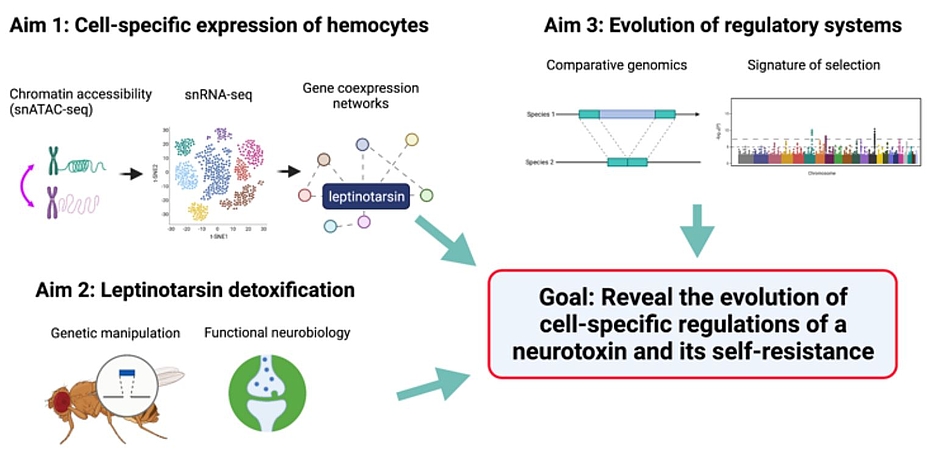Xu/Silies/Keller Valsecchi
Studying Evolution of cell-specific regulations of a neurotoxin and its self-resistance
Supervisor: Shuqing Xu
Co-Supervisor: Marion Silies, Claudia Keller Valsecchi
Scientific Background:
Many insects produce toxins in their hemolymph that are lethal to their predators but not to themselves (1). To achieve this, insects must specifically regulate the production of the toxins and evolve self-resistance at the cellular level. However, the underlying mechanisms and evolutionary processes remain largely unknown.
PhD project: Studying Evolution of cell-specific regulations of a neurotoxin and its self-resistance
Leptinotarsa hemolymph produces a high abundance of leptinotarsin, a presynaptic neurotoxin that is lethal to many insects and vertebrates but harmless for the carriers (2, 3). The peptide suggests that the toxin evolved from a duplicated juvenile hormone esterase (JHE), which is specifically expressed in hemolymph (4). While the regulation of JHE is age-dependent (5), leptinotarsin is found in all developmental stages. Our preliminary data suggest that leptinotarsin is produced in a specific type of hemocyte cells, suggesting the evolution of new gene regulations of leptinotarsin. Here, we will use tools from comparative genomics and single-cell sequencing to study the mechanisms and evolution of cell-specific regulations of leptinotarsin. In addition, we will investigate the mechanisms of toxin self-resistance using a functional neurobiology approach. Specifically, we will address three questions:
1) Which cells produce leptinotarsin and how is it regulated at the cellular level?
2) What are the mechanisms of the leptinotarsin self-resistance?
3) How did leptinotarsin and its resistance mechanism evolve?
We will first perform single-cell RNA-sequencing (scRNA-seq) on Colorado potato beetle (Leptinotarsa decemlineata) hemocytes to characterize the cellular regulations of leptinotarsin (Aim 1). We will further use single-cell ATAC-sequencing to investigate how chromatin structures contribute to the evolution of cell-specific regulations of leptinotarsin. Second, we will investigate possible mechanisms of leptinotarsin self-resistance by investigating synaptic targets of leptinotarsin in Drosophila (Aim 2). Third, we will retrace the evolutionary history of leptinotarsin and the toxin self-resistance mechanisms by analyzing the genomes of closely related Leptinotarsa species and other insects (Aim 3). Comparing the target molecules in species that are susceptible to the toxin with resistant species will provide insights into the evolution of resistance mechanisms. We hypothesize that leptinotarsin evolved new regulations via changing cell-specific chromatin accessibility, the process of which is after the emergence of self-tolerance. Together, this project will provide new insights into the evolution of novel gene regulatory networks at the single-cell level.

Project integration
The PhD student and project will be conducted under the joint supervision of Prof Shuqing Xu and Prof Marion Silies. This project will further benefit from expertise of Dr. Claudia Keller Valsecchi on the mechanism of epigenetic regulations.
Publications relevant to this project
1. K. Dettner, Toxins, defensive compounds and drugs from insects. Insect molecular biology and ecology, 39-93 (2015).
2. T. H. Hsiao, in Toxins, P. Rosenberg, Ed. (Pergamon, 1978), pp. 675-688.
3. T. H. Hsiao, G. Fraenkel, Properties of leptinotarsin. A toxic hemolymph protein from the Colorado potato beetle. Toxicon 7, 119-130 (1969).
4. R. D. Crosland, R. W. Fitch, H. B. Hines, Characterization of beta-leptinotarsin-h and the effects of calcium flux antagonists on its activity. Toxicon 45, 829- 841 (2005).
5. S. J. Kramer, C. A. DeKort, Age-dependent changes in juvenile hormone esterase and general carboxyesterase activity in the hemolymph of the colorado potato beetle, Leptinotarsa decemlineata. Mol. Cell. Endocrinol. 4, 43-53 (1975)